A miner’s wallet sent 50 BTC to a centralized exchange after lying dormant for 14 years. The block reward, mined in July 2010, is now worth around $3M.
Miners and early block producers were few in the early days of Bitcoin (BTC). One of those lucky block producers decided to take profit on a whole block reward. The wallet shows a record of a single block mined, no other activity, and then a transfer to a known exchange address.
A miner wallet woke up after being dormant for 14 years and deposited 50 $BTC($3.05M) to #Binance 7 hours ago.
The miner earned 50 $BTC from mining on July 14, 2010.
Address:
1PDTDwpgRPdQaCcp3Th6zaMASgcCcm3Jcm pic.twitter.com/toKmBfbUne— Lookonchain (@lookonchain) June 27, 2024
The wallet still holds the 50 Bitcoin Cash (BCH), the first forked Bitcoin coin. Presumably, this would apply to other forks as well, though having a much lower value.
Early miners show the value of holding one’s own private keys
This early miner is more of a curiosity than a trend. Most wallets with coins older than 10 years tend to hold them for the long term. Large-scale miners have a more deliberate strategy to take profits, with an outlook on covering costs or investing in new equipment.
Also Read: Miners’ Bitcoin reserves at 14-year low as fiat value nears ATH
In this case, the wallet most probably belongs to a hobby miner, and the block was found with practically very little difficulty. Bitcoin mining did not start to become competitive until 2013.
The recent complete sale also pointed out that there are many reluctant long-term holders of BTC, who would have loved to cash in. In the coming months, the market may have to absorb the selling of Mt. Gox reserves, as the offered deal was to repay holders in cash, not in kind.
When it comes to long-term holding, the recent trade shows the value of holding one’s own private keys, instead of relying on an exchange wallet. Once a private seed is safely known, a user can always recover their holdings.
In the past day, additional funds have been sent to centralized exchanges, coming from unidentified wallets. Unknown personal wallets transferred nearly 6,000 BTC to Binance, Kraken, and Coinbase on Friday.
🚨 🚨 🚨 🚨 🚨 🚨 🚨 🚨 3,022 #BTC (185,873,027 USD) transferred from unknown wallet to #Coinbasehttps://t.co/G5XyUIOfFP
— Whale Alert (@whale_alert) June 27, 2024
Earlier this year, another wallet from 2010 moved 1,000 BTC, acquired after much more active mining. Some early holders have also revealed stories of hardware recovery, either from old phones or hardware wallets. The cohort of holders with wallets aged 5-6 years is also selling, as they have seen recent examples of prolonged bear markets and short chances for maximum profit-taking.
Bitcoin miners now sell both old and new coins
The 50 BTC sold from one private wallet is a drop in the ocean. Miners hold an estimated 1.8M coins and produce 450 new coins per day. They also need to cover electricity costs, which are in some cases fixed based on long-term contracts.
Also Read: When Bitcoin falls, BTC miners suffer – Post-halving’s chronicles
In the past, miners have sold BTC at a rate of more than five times the production cost. Some may have significant reserves, but there is also the requirement to constantly update mining rigs. Mining machines are lost to attrition, but there is also a need to keep up with the near-peak difficulty. Mining ASICs are also priced flexibly, meaning some miners have added costs just to stay in the game.
$BTC miners are selling close to 100% of the coins they are mining
Why? Because the breakeven cost to mine for many is higher than current price
That's ~900 million per month
In 3 years the difficulty to mine $BTC is up 600% but price is not https://t.co/2fiM3tg3ei pic.twitter.com/NKjFcVhyLY
— Pratik Kala (@PratikKala) June 23, 2024
Some miners have also switched to easier networks like Kaspa, though again with the intention of selling the coins to cover costs.
BTC miners are still some of the biggest holders, but selling at these price levels is seen as insurance against another bear market. The last bear market extended for 490 days, and through that time, miners also expanded operations. Mining farms are also exploring AI model training as a source of paid computation.
The current series of sales is somewhat worrying for the markets, as it may signal this year’s $75,000 price record was the cycle’s peak. However, there are also expectations of a temporary setback, while the market absorbs the additional selling.
BTC traded at $61,550.43 on relatively low trading volumes of $22B in 24 hours. BTC shows a clear downtrend in June, from levels above $72,000.
Cryptopolitan reporting by Hristina Vasileva





